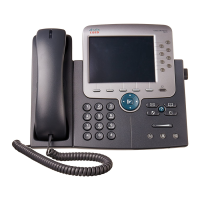1-7
Cisco Unified IP Phone 7975G Administration Guide for Cisco Unified Communications Manager 6.0
OL-12642-01
Chapter 1 An Overview of the Cisco Unified IP Phone
What Features are Supported on the Cisco Unified IP Phone 7975G?
• Understanding the Phone Startup Process, page 2-7
• Network Configuration Menu, page 4-5
What Features are Supported on the Cisco Unified IP Phone
7975G?
The Cisco Unified IP Phone functions much like a digital business phone, allowing you to place and
receive telephone calls. In addition to traditional telephony features, the Cisco Unified IP Phone includes
features that enable you to administer and monitor the phone as a network device.
This section includes the following topics:
• Feature Overview, page 1-7
• Configuring Telephony Features, page 1-8
• Configuring Network Parameters Using the Cisco Unified IP Phone, page 1-8
• Providing Users with Feature Information, page 1-9
Feature Overview
Cisco Unified IP Phones provide traditional telephony functionality, such as call forwarding and
transferring, redialing, speed dialing, conference calling, and voice messaging system access.
Cisco
Unified IP phones also provide a variety of other features. For an overview of the telephony
features that the Cisco
Unified IP Phone supports, see the “Telephony Features Available for the Phone”
section on page 5-2.
As with other network devices, you must configure Cisco Unified IP Phones to prepare them to access
Cisco
Unified Communications Manager and the rest of the IP network. By using DHCP, you have
fewer settings to configure on a phone, but if your network requires it, you can manually configure an
IP address, TFTP server, and subnet mask. For instructions on configuring the network settings on the
Cisco
Unified IP Phones, see Chapter 4, “Configuring Settings on the Cisco Unified IP Phone.”
The Cisco Unified IP Phone can interact with other services and devices on your IP network to provide
enhanced functionality. For example, you can integrate the Cisco
Unified IP Phones with the corporate
Lightweight Directory Access Protocol 3 (LDAP3) standard directory to enable users to search for
co-workers contact information directly from their IP phones. You can also use XML to enable users to
access information such as weather, stocks, quote of the day, and other web-based information. For
information about configuring such services, see the
“Configuring Corporate Directories” section on
page 5-18 and the “Setting Up Services” section on page 5-20.
Finally, because the Cisco Unified IP Phone is a network device, you can obtain detailed status
information from it directly. This information can assist you with troubleshooting any problems users
might encounter when using their IP phones. See
Chapter 7, “Viewing Model Information, Status, and
Statistics on the Cisco Unified IP Phone,” for more information.
Related Topics
• Configuring Settings on the Cisco Unified IP Phone, page 4-1
• Configuring Features, Templates, Services, and Users, page 5-1
• Troubleshooting and Maintenance, page 9-1

